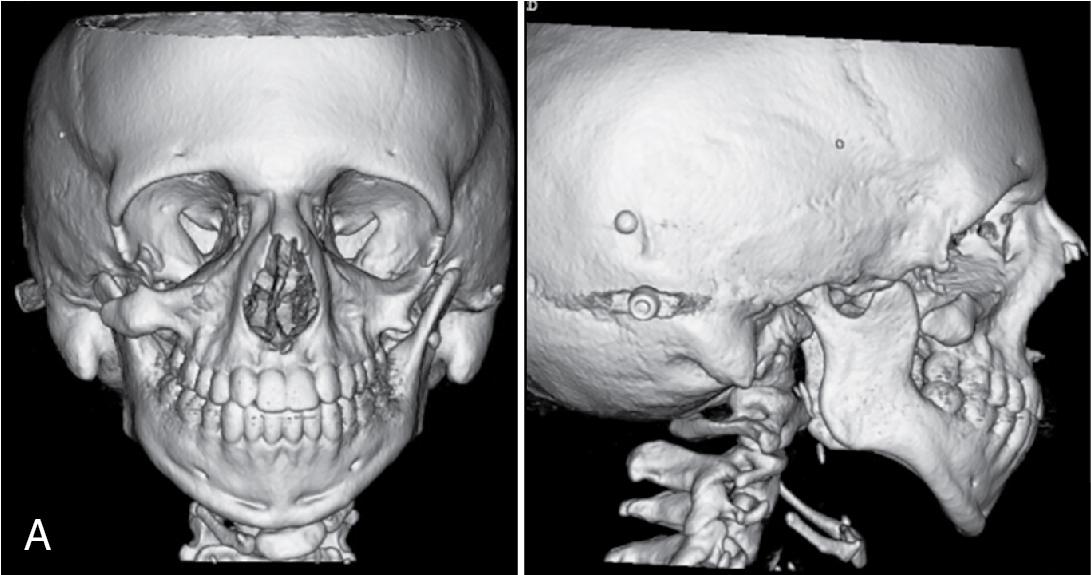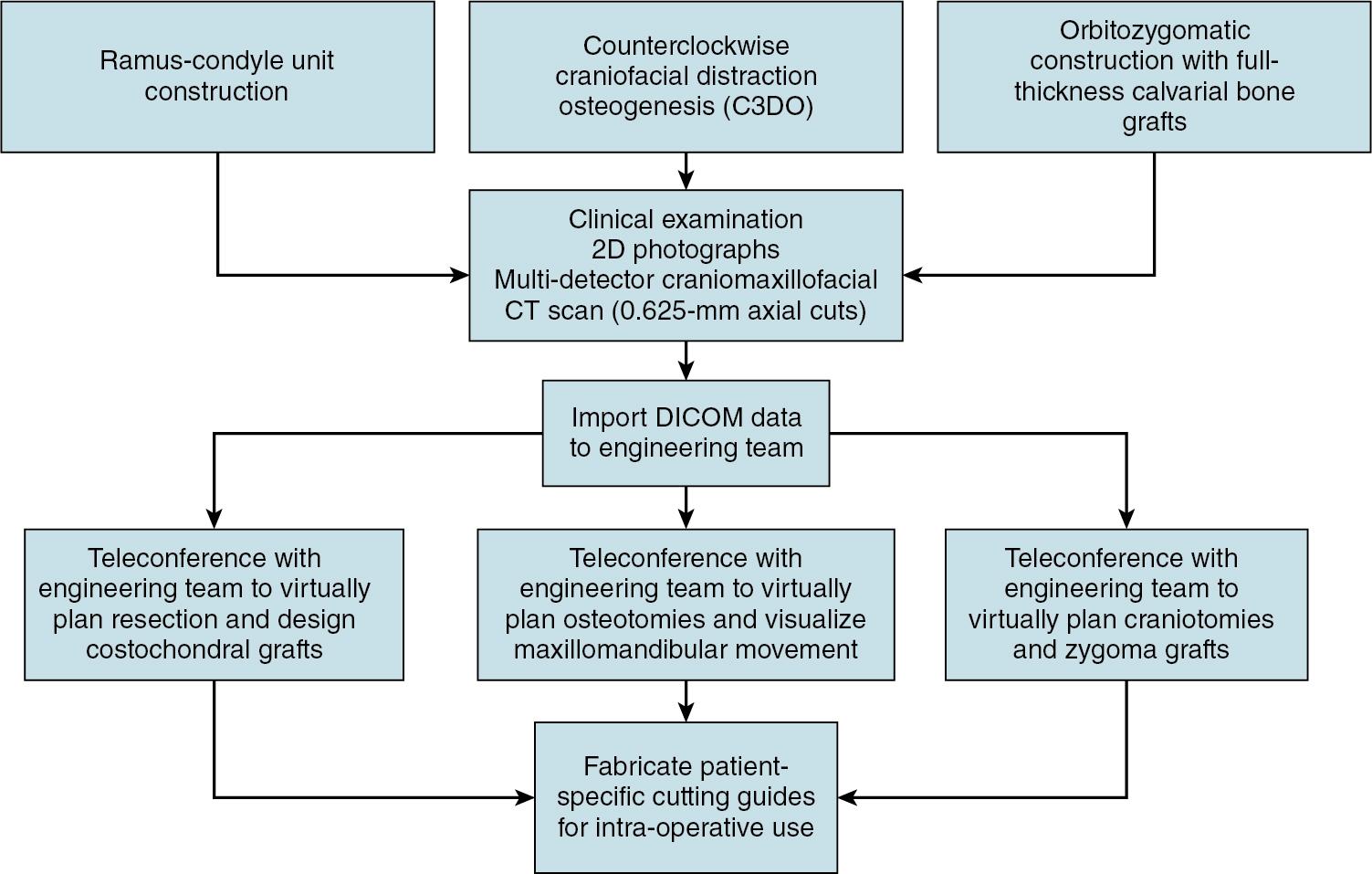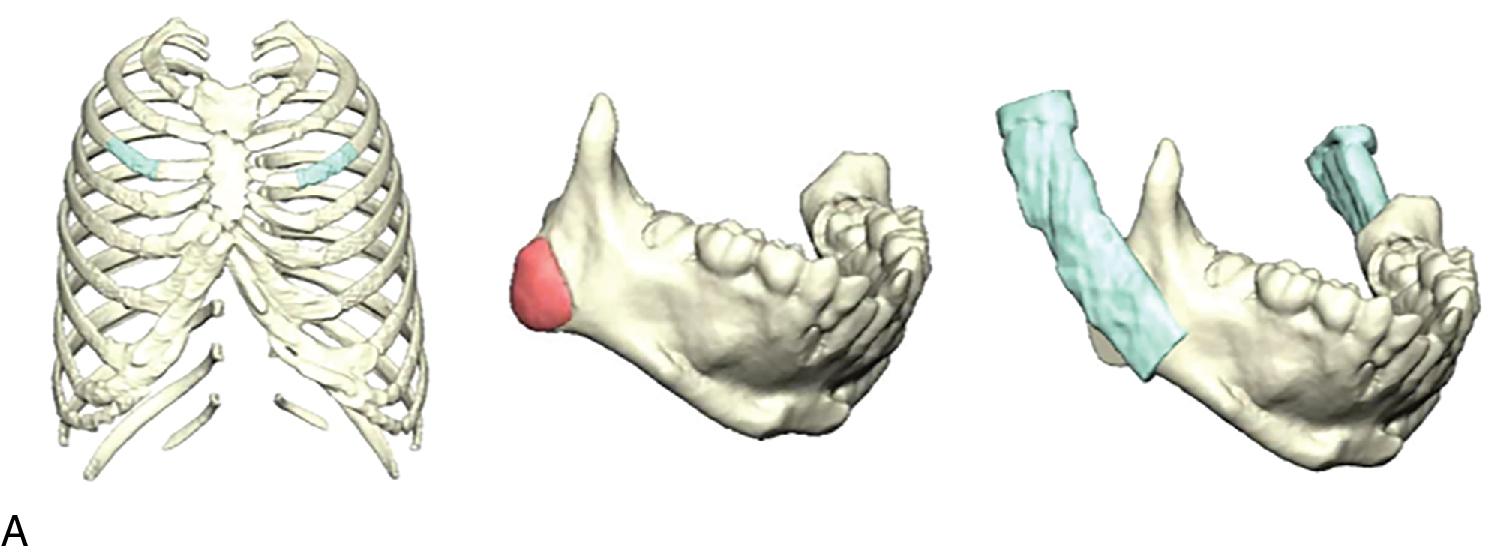Physical Address
304 North Cardinal St.
Dorchester Center, MA 02124
Although classically described as “mandibulofacial dysostosis,” contemporary understanding of the three-dimensional (3D) skeletal dysmorphology in patients with Treacher Collins syndrome (TCS) extends to include midface hypoplasia involving the zygoma and maxilla. The hallmark of severe deficiency is orbitozygomatic hypoplasia with a clockwise rotation deformity of the maxillomandibular complex related to severe mandibular ramus-condyle unit deficiency ( Fig. 14.1 ). This constellation of findings frequently results in critical narrowing of the upper airway and tracheostomy dependence. As the deformity is nonprogressive, sequential interventions over time have proven effective at addressing the dysmorphology. In the most severe cases, the sequence of interventions includes costochondral graft placement to establish a mandible-skull base articulation followed by coordinated maxillomandibular distraction with advancement and counterclockwise rotation, zygomatic construction with calvarial bone graft, and orthognathic surgery at skeletal maturity to address residual airway disease and establish appropriate dentoskeletal relationships. Computer-assisted surgical planning (CaSP) has greatly enhanced the craniomaxillofacial surgeon’s ability to precisely create the appropriate anatomic relationships at each step along this care pathway, ensuring a predictable plan of care.

Originally developed to describe the mandibular deficiency in craniofacial microsomia, the Pruzansky-Kaban classification has been applied to TCS. , The severity of the mandibular deficiency is related to the articulation between the ramus-condyle unit and glenoid fossa ( Table 14.1 ). In the most severe cases (Pruzansky-Kaban type III), there is no articulation between the mandible and the skull base. In these patients, precise reconstitution of the anatomy is essential to establish a centric relationship between the mandible and temporal skull base and set the stage for subsequent interventions, which will rely on this articulation to correct the sagittal and vertical discrepancies of the maxillomandibular complex.
| Classification | Phenotype |
|---|---|
| Type 0 | Normal mandible |
| Type 1 | Hypoplastic mandible with all structures normal in shape and position |
| Type 2 | Small and abnormally shaped mandibular ramus with hypoplastic temporomandibular joint (TMJ) |
| Type 2A | With acceptable TMJ function |
| Type 2B | TMJ is anteriorly, medially, and inferiorly displaced and nonfunctional |
| Type 3 | Complete absence of ramus-condyle unit and TMJ |
Once a stable centric relationship has been established, coordinated maxillomandibular rotation-advancement can be used to address the clockwise rotation deformity. In this stage of reconstruction, a Le Fort II osteotomy (or Le Fort III osteotomy in patients with developed zygomas) is performed in combination with bilateral mandibular inverted-L osteotomies. The osteotomized midface-mandibular complex is then advanced and counterclockwise rotated around the nasofrontal junction in a coordinated fashion utilizing distraction osteogenesis.
Following appropriate reconstitution of the midface and mandibular anatomy with coordinated subcranial-mandibular distraction, many patients with TCS will be able to be decannulated. The stable skeletal framework for the central midface and craniomandibular articulation sets the stage for coordinated orthodontic-surgical management of the dentoskeletal relationships at skeletal maturity. For patients with zygomatic hypoplasia, reconstruction of the orbitozygomatic complexes can be undertaken as the next step in staged management. Since the rotation surgery is performed after 7 years of age, the subsequent malar reconstruction can be sized to anticipate the desired morphology at skeletal maturity.
Construction of the orbitozygomatic complexes is most reliably accomplished using full-thickness calvarial bone grafts. Partial-thickness grafts or grafts from other donor sites (iliac crest, rib) have unpredictable rates of incorporation/resorption. Our preference is to use parietal bone grafts, based upon the concordance between the curvature of the skull in this region and the contour necessary to create appropriate zygomatic projection.
The workflow for computer-assisted design and computer-assisted manufacturing (CAD/CAM) is shown in Fig. 14.2 .

In patients with aplasia of the ramus-condyle units (Pruzansky-Kaban Type III, Fig. 14.1 ), first-stage reconstruction, ideally in the late primary dentition, involves the use of autologous rib grafts to establish a stable craniomandibular articulation, in anticipation of coordinated maxillomandibular distraction in the mixed dentition. In this regard, CaSP is a critical adjunct. The 3D anatomy of the dysmorphic mandible can be carefully mapped and customized cutting and positioning guides can be designed to harvest costochondral grafts of the exact size needed to create the mandible-glenoid fossa relationship ( Fig. 14.3 ). CaSP in the 3D environment will also allow the surgeon to establish appropriate points for fixation, avoiding the inferior alveolar nerve and developing tooth buds.

Become a Clinical Tree membership for Full access and enjoy Unlimited articles
If you are a member. Log in here